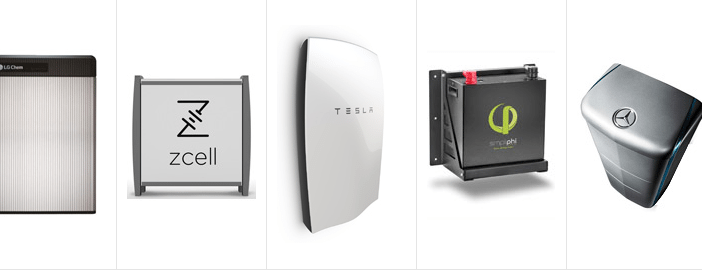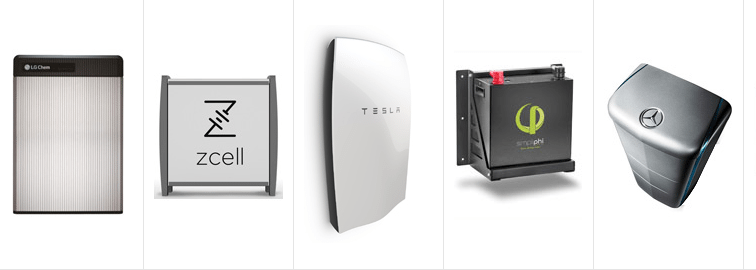
For all the hype around battery storage – and the growing array of new products – there is still great deal of speculation about when it will take off in Australia, and led by what sector.
According to the industry, a boom in residential battery storage imminent, with all that “dumb solar” sitting on Australian rooftops, and various generous state feed-in tariffs set to disappear.

According to analysts, if household battery storage does take off as early as next year, it won’t be due to great return on investment – we’re not there yet, and we won’t be there until 2018 at the earliest, and even then only for certain households on certain tariffs.
But probably the most popular view – if not the most economically rational – is that ROI will be largely irrelevant. For the majority of Australian households looking at battery storage, they just want to make the most of their solar investment and use as little grid supplied energy as possible.
In the spirit of this last view, we thought it was time to take look at some recommendations on battery storage: Should you get it? And if you do, what should you get? Here are three different expert points of view:
1. The energy analyst: Energeia
As a specialist energy market researcher, Energeia falls into the category of ‘very few households – and especially not those households on a flat tariff – are economically better off investing in a battery system.’
Of course, this is expected to change quite quickly. According to its recent two-part analysis on battery storage, Energeia says it is “inevitable” that solar-storage economics will improve, driven by the current vendor/retailer ‘arms race’ and possible changes to tariffs that would improve investment returns for customers to a point that was “sufficiently lucrative to create large household market demand.”
For example, things improve rapidly and considerably for households on maximum demand tariffs, but that remains a hypothetical in most states (you can read more about the proposed shift to demand tariffs here).
In the meantime, a key takeaway message from Energeia for those looking to invest now is that smaller is probably better.
“For most solar storage offerings at the moment …the optimal system is actually around 1-2kWh,” said Energeia analyst Jacob Kharoufeh at the All-Energy Australia conference in Melbourne last Tuesday. “Initially, until the cost comes crashing down, there is a niche market for operators offering modular units,” he said.
And this is reiterated by Energeia’s Residential Solar and Storage Analysis – Part 2, and illustrated in their chart, below.

“At a battery price of $1,000/kWh, which is close to today’s prices, there is a significant value proposition for a large number of households to adopt a smaller 1kWh battery,” the report says.
“The first kWh of battery capacity delivers the most value,” it says. “For small/medium solutions, there is a significant opportunity today (~2 million households), providing a significant first mover advantage, particularly for the retrofit market.
“The small battery total addressable market remains resilient (2.5 – 3 million households) despite significant battery cost deflation potential, highlighting the economic importance of utilisation and right sizing solutions to maximise customer benefits,” the report says.
At this stage, small battery offerings in the Australian market include Enphase Energy’s 1.2kWh lithium-iron phosphate AC Battery, which as Solar Quotes notes, was designed to be scalable and offers “great $/kWh if cycling twice a day.”

Aquion and Sonnenbatterie both also offer smaller, scalable battery units, at 2.2kWh and 2kWh respectively. On Aquion, Solar Quotes says it is a great price per kWh, “modular, environmentally friendly disposal, inherently safe chemistry (low fire risk compared to lithium ion)” and is also available in a 24V version, which enables the use of lower cost inverters and chargers.
2. The solar and storage developer
The second view we will look at comes from Bjorn Sturmberg, who is a co-founder and director at Kairos Power, a community solar and storage project manager, and a postdoctoral researcher at Macquarie University.
One Step Off the Grid regulars may recall Bjorn from his efforts in project managing the installation of 30kW of rooftop solar and a 43.2kWh Enphase battery storage system at an eight-unit student housing co-operative in the Sydney suburb of Newtown – a first of its kind in Australia.
Sturmberg says his advice to “early adopters” looking to get battery storage – which he believes will “revolutionise home energy supply – is born out of his experience with the Stucco housing co-operative, particularly the procurement decision making process.
His advice is as follows:
“Currently, the energy storage market is still in a self-confessed early adopter phase: there’s plenty of potential and excitement, however there are also plenty of risks that have not yet been fully resolved.
Making purchasing decisions in this rapidly evolving space is hard; there are lots of different storage technologies being manufactured by an ever growing number of companies, who are experimenting with a wide range of business models.
While most consumers will wait out these turbulent times, many (the early adopters by definition) are eagerly embracing change.
The following information may be a useful resource for those assessing their current options. For more background information see here.
– Firstly, size your system for your individual circumstances; this is not an easy task – for starters see here.
– Secondly, get many quotes – solarquotes.com.au is a good starting point.
– Thirdly, assess and compare the proposed quotes. This is where the rich fruit salad of technologies and companies makes it tricky to get an apples-to-apples comparison; the following information is intended to help structure this process.
I recommend starting your assessment by writing down your priorities (see pic 1, right). With these priorities in mind, I then recommend filling out a more detailed comparison chart.
[pdf-embedder url=”onestepoffthegrid.com.au/wp-content/uploads/2016/10/SolarStorage_procurment_matrix-edit-2.pdf” title=”solarstorage_procurment_matrix-edit”]
While this chart cannot possibly capture the full complexities of these energy systems, something of this nature is a good starting point to a short-list and some directed questions.*
Lastly, be curious – these systems are not yet standardised and information is key to making good decisions. Ask questions, and don’t trust those who cannot explain their proposals simply and comprehensively.”
3: The popular view…
In his speech at All-Energy Australia last week, Solar Analytics CEO Stefan Jarnason said “residential solar and storage will eat the energy world… and Australia is the proving ground.”
Jarnason, whose company specialises in “smart solar” technology, said that his household, like many others in NSW and Victoria that are coming off generous feed-in tariffs, would be putting in a battery. But the question is, which size?
To answer that question, says Jarnason, you need to first invest in some intelligence: a gadget – and there are many of them on the market – that “connects up to your household consumption, connects up to your inverter, and gives you high resolution live data.”
You need all this, he said, because to decide what is the right battery will be influenced significantly by what network you’re on, by how you use your energy, by the size of the solar system you have, and also by the different tariffs.
(As it happens, Solar Analytics has come up with a sort of battery storage calculator, which, once you have signed up for their Solar Analytics Monitoring service, helps customers work out what battery size would best suit them – you can find their Solar Calculator here.)
Jarnason says the company currently has about 11,000 systems under monitoring, and “a lot of… customers inquiring about batteries.”
And the reason they’re inquiring about batteries is really interesting, he says. It’s not to take advantage of rebates – save for some houses in Adelaide; it’s not (yet) for payback; it might be environmental; but it’s probably mostly about “telling utilities to go and take a big running jump.”
“it’s this last one that I personally feel is an extremely strong motivator,” Jarnason told the conference. “And we know this because the well off among us are the lowest uptake of people of solar around.
“Payback is not what everybody is looking for,” he added. “What they’re looking for is, what will it do for them?”
On that note, here’s what some of his customers are doing – and why:
Customer case study #1: “On a nice sunny day, with a 5kW system, two arrays north-east, worth-west, 30° tilt, this household is getting 31 per cent solar utilisation. So 31 per cent of their energy comes from their solar. And they’re not terribly happy about that.
“They put in a 6kWh battery… they’re saving $458 a year and they’ve now got 78% of their energy coming from either their battery or their solar.
“Importantly, they’re only importing 14 per cent of their total energy, which makes them much, much, much happier.
Customer case study #2: “Another site in NSW with a 4.2kW split array, using 48 per cent of their solar. That was boosted up to 80 per cent with a small battery (using Solar Analytics calculator).
“This household hasn’t bought a battery yet, but I suspect they will, funnily enough, some time after January.
“The question will be do they put in the financially optimal 2kWh or do they go for bigger. I don’t know, I think that number 80 per cent is really what’s going to drive that decision.
“They have cut grid use right down to 12 per cent, which makes them feel much happier.”
What’s important, added Jarnason, “if you have a solar system is to make sure that you get the right battery for your home.
“So for our 11,000 customers, for the vast majority of them right now, it doesn’t make a lot of financial sense. For quite a few of them it’s actually starting to make sense, and we see that number… increasing all the time, and the number of inquiries we’re getting from them continually going up.
“And hopefully if we come up with some more inventive tariffs it will make storage even more attractive. Because, quite frankly, my view, we want everyone to stay connected to the grid. The worst outcome for all of us is if our regulators and our utilities start making life difficult for us and we all start disconnecting from the grid. That would be horrible. Batteries can actually produce a win-win-win situation.”
(*Bjorn Sturmberg’s assessment tools were developed in collaboration with Louis Janse van Rensburg and the consultants from Chargeworks, with the support of the NSW Office of Environment and Heritage. The documents are licensed under a Creative Commons Attribution 4.0 Licence.)

Sophie is editor of One Step Off The Grid and deputy editor of its sister site, Renew Economy. Sophie has been writing about clean energy for more than a decade.




